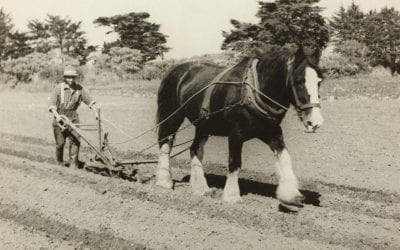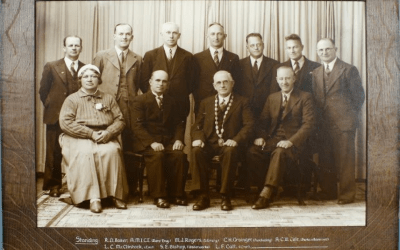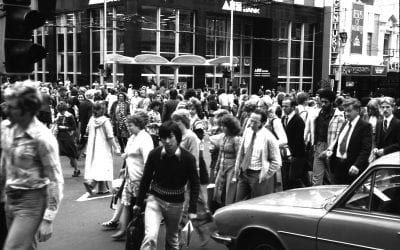AHI Summer Research Scholarships
Research Articles
The Borders of Identity: Illusions in Auckland’s Chinese History
by Hanna Lu*
Let’s start with an end. ‘Chinatown’, located in what is now the city centre’s Greys Avenue, faded out of existence in the 1960s. As its buildings were demolished and its residents moved out, the 1966 Auckland Star published an article in which the author mourned that “Chinatown has gone—and with it one of the more colourful links with Auckland’s past”.
Auckland’s Chinese: Home, Youth and Joy in Turbulence
by Hanna Lu*
To live and die in the same place in the age of wanderlust is to incite pity from those who have only ever seen travel as a voluntary adventure. It’s an opportunity for growth and for excitement — but always with the knowledge that home is there, waiting patiently, for the traveller to come home to. For migrants, things are different.
The Standing Point: Studying the History of Auckland’s Chinese People
by Hanna Lu*
History is not about us. I mean, the people involved are usually not us. But the stories we tell are about ourselves, and who we’ve been, and what we mean when we say ‘ourselves’. Are there concepts of who we are that rest on the exclusion of certain groups?
Two Powerful Voices in Diverse Communities
by Brooke Stevenson*
Mere Newton and Mary Dreaver were two women in politics in the 1930s that commanded an influential were voice within their respective communities. On the 28th August 1939, Mere Newton suspended standing orders of the Onehunga Borough Council Meeting to highlight the need for better Māori housing in their community.
Female Perspectives and Female Issues: Different approaches to politics
by Brooke Stevenson*
Mere Newton, local Māori politician and social worker, and Mary Dreaver, a daughter of Scottish immigrants and a national politician, operated within their vastly different spheres of influence in 1937. However, Newton and Dreaver’s isolated worlds merged on the 12th June 1937 when Mere Newton invited Mary Dreaver to become a guest speaker to the ladies’ social committee of the Epsom-Oak branch of the Labour Party.
Women Emerging from the Auckland Political Scene: Introducing Mere Newton and Mary Dreaver
by Brooke Stevenson*
Auckland’s female political history has been more vibrant and diverse than one might assume. After trail blazers such as Elizabeth Yates and Ellen Melville, we see the emergence of women who become experts in mastering the art of networking and public speaking, bringing their own feminine approach and experiences into local and national level politics.
After the Trial Mall: Queen Street’s Stagnated Development
by Nancy Mitchelson*
In August of 1979, things were still looking hopeful for a proposed pedestrian mall in Queen Street, following the carnival-like, week-long trial in May. Furthermore, the closing off of the Wellesley/Victoria street block was approved by the ACC policy and finance committee.
“Yours Disgustedly”: Public Reactions to the Queen Street Mall Project
by Nancy Mitchelson*
Deep in the Auckland City Council archives, direct democracy of a bygone era has been wholly preserved in fountain pen and typewriter ink. This takes the form of copious amounts of letters to the mayor and planning committee, reacting to one of the most controversial and, dare I say, tantalising issues of the time: the pedestrianisation of Queen Street.
“Go to a Poetry Reading and Get Hit by a Bus”: The Queen Street Mall Trial, May 1979
By Nancy Mitchelson*
It was first week of the 1979 May school holidays and Auckland’s main thoroughfare was to be closed for a trial pedestrian mall. A trial was initially approved due to pressure from the Tramways union, whose trolley bus drivers wanted to ensure public safety if a permanent mall was to be given the green light.
The Mall Gets Stalled: A Planning Timeline of the Queen Street Pedestrian Mall
By Nancy Mitchelson*
The concept of closing part of Queen Street to cars and creating a pedestrian oasis in the middle of Auckland’s own ‘Golden Mile,’ is not a novel one. In fact, this idea has existed in some form since at least 1968, when Mayor Sir Dove-Myer Robinson made it the cornerstone of his mayoral campaign platform.
Stopping the Rot: The Central Area Plan, Sir Dove Myer Robinson, and searching for the purpose of Central Auckland in the 1970s
by Nancy Mitchelson*
It was the 1970s, and Auckland’s central area was facing a crisis of purpose. This crisis had been brewing for some time, born out of the growth of the motor car, a rapidly expanding motorway network, and developing state housing in an emerging suburbia.
Resilience
By Nicolas Jones*
The Māori Community Centre, set up in 1947, was an important component in the reestablishment of Ngāti Whātua Ōrākei’s community identity. During a period of significant upheaval and devastation for Ngāti Whātua, the Centre provided space for a temporary Marae and supported the process of rebuilding within the hapū.












